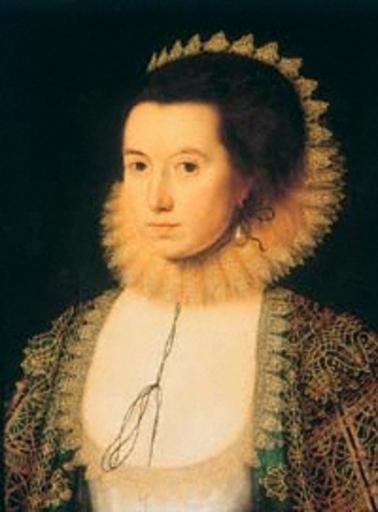MAKE A MEME
View Large Image

| View Original: | Anne_Clifford,_Countess_of_Pembroke.jpg (200x271) | |||
| Download: | Original | Medium | Small | Thumb |
| Courtesy of: | www.flickr.com | More Like This | ||
| Keywords: people Lady Anne Clifford (January 30, 1590 – March 22, 1676) was the only surviving child of George Clifford, 3rd Earl of Cumberland (1558–1605) by his wife Lady Margaret Russell, daughter of Francis Russell, 2nd Earl of Bedford. Their marriage was soured by the deaths of Anne's two elder brothers: her parents lived apart for most of her childhood. In her young adulthood she was involved in a long and complex legal battle to obtain her rights to her inheritance. She was brought up in an almost entirely female household—evoked in Emilia Lanier's Description of Cookeham—and given an excellent education by her tutor, the poet Samuel Daniel. As a child she was a favourite of Queen Elizabeth I of England; she also danced in masques with Anne of Denmark, queen of King James I of England. She was the Nymph of the Air in Daniel's masque Tethys's Festival, and filled roles in several of the early Court masques of Ben Jonson, including The Masque of Beauty (1608) and The Masque of Queens (1609). Lady Anne's first husband was Richard Sackville, 3rd Earl of Dorset. After his death in 1624, she married Philip Herbert, Earl of Pembroke and Montgomery in 1630. Both marriages were reportedly difficult; contemporaries sometimes cited Lady Anne's unyielding personality as a cause. (Her cousin Edward Russell, 3rd Earl of Bedford compared her to the Rhone River.)[1] A more sympathetic view would blame some of the troubles in her first marriage on her husband's spendthrift extravagance and his infidelities. She was an important patron of authors and literature; her letters, and the diary she kept from 1603 through 1616, have made her a secondary literary figure in her own right. She bore five children—though none of their three sons survived to adulthood. A central conflict with her second husband lay in a choice of husband for her younger daughter. Her long-running struggle for her inheritance met with a late success in 1649, when she took possession of the Clifford family's northern castles and estates.[2] The artist Jan van Belcamp painted a triptych portrait of Anne Clifford to her own design and specifications. Titled "The Great Picture," it portrays Lady Anne at three points in her life—at age 56, at age 15, and before birth in her mother's womb. In connection with the painting, Anne Clifford dated her own conception to May 1, 1589—certainly an unusual act of precision.[3] In 1656, she erected the Countess Pillar in memory of her late mother. She restored churches at Appleby-in-Westmorland, Ninekirks, Brougham and Mallerstang. She was also responsible for the improvement and expansion of many of the Clifford family's castles across Northern England, including those at Pendragon (Mallerstang), Brough, Skipton and Appleby, the last being her home.[4] At her death, aged 86, she was the Dowager Countess of Dorset, Pembroke, and Montgomery. Her tomb is in St Lawrence's Church, Appleby-in-Westmorland. Lady Anne Clifford (January 30, 1590 – March 22, 1676) was the only surviving child of George Clifford, 3rd Earl of Cumberland (1558–1605) by his wife Lady Margaret Russell, daughter of Francis Russell, 2nd Earl of Bedford. Their marriage was soured by the deaths of Anne's two elder brothers: her parents lived apart for most of her childhood. In her young adulthood she was involved in a long and complex legal battle to obtain her rights to her inheritance. She was brought up in an almost entirely female household—evoked in Emilia Lanier's Description of Cookeham—and given an excellent education by her tutor, the poet Samuel Daniel. As a child she was a favourite of Queen Elizabeth I of England; she also danced in masques with Anne of Denmark, queen of King James I of England. She was the Nymph of the Air in Daniel's masque Tethys's Festival, and filled roles in several of the early Court masques of Ben Jonson, including The Masque of Beauty (1608) and The Masque of Queens (1609). Lady Anne's first husband was Richard Sackville, 3rd Earl of Dorset. After his death in 1624, she married Philip Herbert, Earl of Pembroke and Montgomery in 1630. Both marriages were reportedly difficult; contemporaries sometimes cited Lady Anne's unyielding personality as a cause. (Her cousin Edward Russell, 3rd Earl of Bedford compared her to the Rhone River.)[1] A more sympathetic view would blame some of the troubles in her first marriage on her husband's spendthrift extravagance and his infidelities. She was an important patron of authors and literature; her letters, and the diary she kept from 1603 through 1616, have made her a secondary literary figure in her own right. She bore five children—though none of their three sons survived to adulthood. A central conflict with her second husband lay in a choice of husband for her younger daughter. Her long-running struggle for her inheritance met with a late success in 1649, when she took possession of the Clifford family's northern castles and estates.[2] The artist Jan van Belcamp painted a triptych portrait of Anne Clifford to her own design and specifications. Titled "The Great Picture," it portrays Lady Anne at three points in her life—at age 56, at age 15, and before birth in her mother's womb. In connection with the painting, Anne Clifford dated her own conception to May 1, 1589—certainly an unusual act of precision.[3] In 1656, she erected the Countess Pillar in memory of her late mother. She restored churches at Appleby-in-Westmorland, Ninekirks, Brougham and Mallerstang. She was also responsible for the improvement and expansion of many of the Clifford family's castles across Northern England, including those at Pendragon (Mallerstang), Brough, Skipton and Appleby, the last being her home.[4] At her death, aged 86, she was the Dowager Countess of Dorset, Pembroke, and Montgomery. Her tomb is in St Lawrence's Church, Appleby-in-Westmorland. | ||||